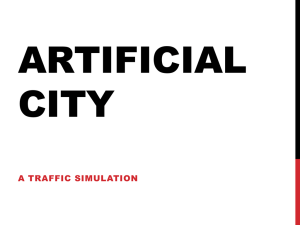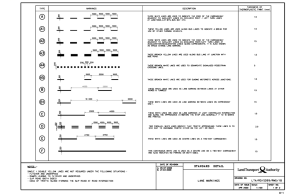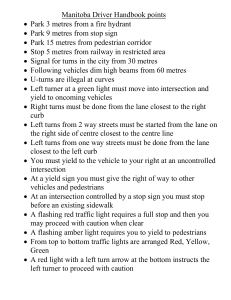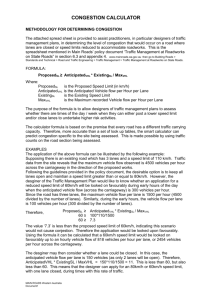Road Capacities - indevelopment.nl
advertisement
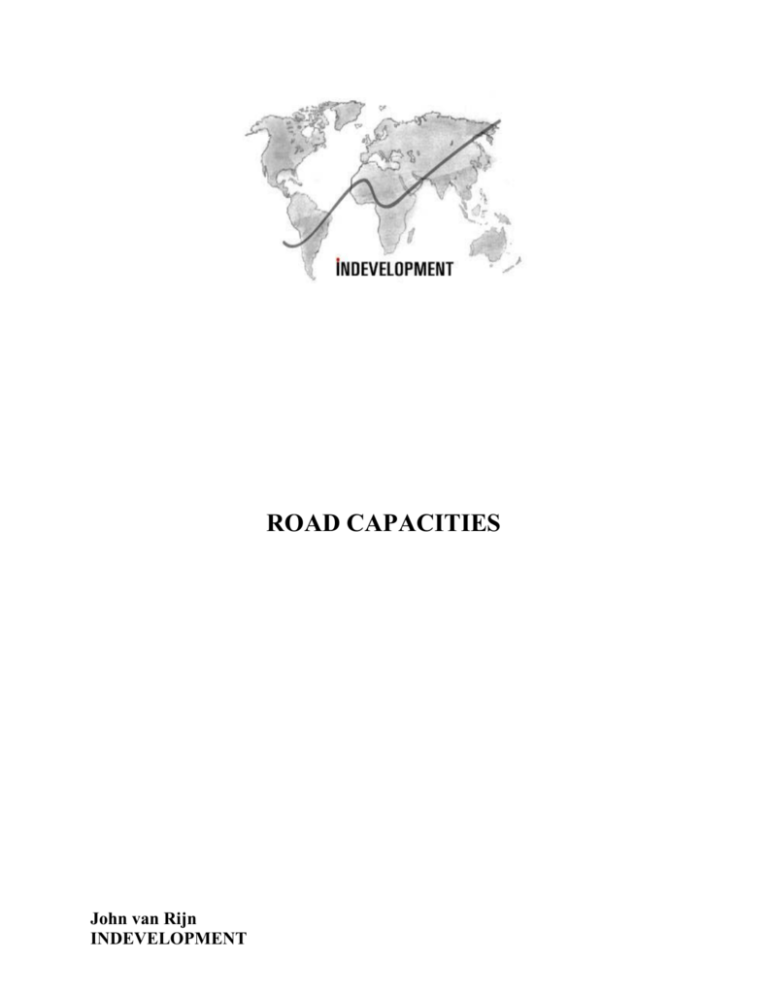
ROAD CAPACITIES
John van Rijn
INDEVELOPMENT
INDEVELOPMENT:
Road Capacities
ROAD CAPACITIES
Any part of this publication may be fully reproduced or translated provided that the source and author are fully
acknowledged.
Edition 2004.
2
INDEVELOPMENT:
Road Capacities
Table of Contents:
1
2
Introduction .............................................................................................................................. 4
Motorways................................................................................................................................ 5
2.1 Capacity and level of service analysis............................................................................... 9
2.1.1
2.1.2
3
Ramps ..................................................................................................................................................10
Weaving sections .................................................................................................................................10
Multi-traffic roads .................................................................................................................. 12
3.1 Signalised intersections ................................................................................................... 12
3.2 Roundabouts .................................................................................................................... 17
3
INDEVELOPMENT:
Road Capacities
1
INTRODUCTION
This document provides information about a traffic flow theory and
simulation models and it provides information about capacities of road
networks.
Capacity is usually defined as:
The maximum hourly rate at which persons or vehicles can reasonably
be expected to traverse a point or uniform section of a lane or roadway
during a given time period under prevailing roadway, traffic and control
conditions.
4
INDEVELOPMENT:
Road Capacities
2
Road networks
Traffic stream characteristics
Intensity
MOTORWAYS
Road networks are composed of intersections and links. If the links are
long enough, the intersections will no longer have influence on the
behaviour of the traffic on a link. The capacity of the road network is
thus different near the intersection than on long links. This chapter will
first discuss the capacities on the long links and subsequently the
capacities of some types of intersections.
The traffic stream has three main characteristics:
• Intensity
• Density
• And mean speed
The intensity of a traffic flow is the number of vehicles passing a cross
section of a road in a unit of time. The intensity is expressed with “q”.
Thus in formula: q= n/T or
Intensity = number of vehicles/unit of time
Density
The density of a traffic flow (k) is the number of vehicles (m) present on
a unit of road length (X) at a given moment.
Thus in formula: k= m/X
If the traffic flow is in a stationary and homogeneous state, then the
following relationship is valid: density multiplied with mean speed (u)
equals the intensity.
In formula: q=k*u
Three fundamental diagrams
In traffic flow theory there are three fundamental diagrams:
Intensity-density q=q(k)
Speed-density u=u(k)
Speed-intensity u=u(q)
5
INDEVELOPMENT:
Road Capacities
The relations in the diagrams tend to depend on characteristics of the
road, drivers and their vehicles and conditions like lightning and
weather.
Eddie
It is therefore common that the exact relationship differ from country to
country but also varies over time. First of all the composition of the
traffic changes but also traffic behaviour is totally different. In western
world people tend to drive faster and keep less distance between the
bumpers of each other cars. On their highways they separated slow
from fast moving traffic and roads are usually lighted. In many low and
middle-income countries traffic behaves in a less disciplined manner
and that affects the average speed of the vehicles.
Eddie was the first researcher to indicate the possibility of a
discontinuity in the diagram around the capacity point. It was observed
that an increasing traffic stream that moves in free flow reaches a
higher capacity than a diminishing traffic stream moving from a
congested situation into a free flow situation.
6
INDEVELOPMENT:
More lanes
Overtaking vehicles
Dominant traffic rules
Keep your lane
Fast lane
Road Capacities
If a road is composed of different lanes, it is not correct to add the
diagrams of the different lanes to compile a diagram for the whole road.
In particular the distribution of the traffic over the different lanes have
major complications. It appears that the upper mean speed of a multilane highway almost remain constant until the road get congested.
This phenomenon can be partly be explained due to changing lanes of
overtaking vehicles and therefore changing intensities at the different
lanes.
This process depends also partly on the traffic rules on multi-lane
roads. Basically there are two systems.
1. Keep your lane
2. Fast lane
Keep your lane implies that traffic will stay in its lane until it wants to
take over another vehicle. To take over the vehicle, it could either move
to the left or right lane as it pleases.
Fast lane system means that vehicles in principle will use the outer
lane, until it wants to take over. After having taken over the vehicles in
the inner lanes, it moves back to the outer lane. Thus the inner lane is
used for taking over only.
When the traffic intensity increases and reaches congestion, more and
more vehicles will stay in the inner lanes, and traffic starts using the
keep your lane system.
With increasing intensity, that starts and still is in free flow situation, it is
noticeable that traffic in the outer lanes are slowing down, while traffic
in the inner (fast) lanes keep their high speed. But because more and
more traffic is using the inner lanes, the average speed of all traffic
tends to remain constant.
7
INDEVELOPMENT:
Maximum free flow
Queue discharge
Road Capacities
To estimate the capacities of roads, it is necessary to take these
aspects into account.
It is possible to calculate the maximum free flow capacity by fitting a
model of the function q(k) to data. The capacity is the maximum of q(k).
To estimate the queue discharge capacity, it is necessary to set-up
three measuring stations in and near the overloaded bottlenecks.
1. Upstream of the bottleneck
2. Downstream of the bottleneck, the traffic should move freely,
thus there is no congestion
3. At the bottleneck
At an overloaded bottleneck the intensities at the three stations are
more or less the same. The station downstream is than used to
measure the traffic flow, because it has the smoothest traffic flow.
8
INDEVELOPMENT:
Road Capacities
2.1
Level of service
CAPACITY AND LEVEL OF SERVICE ANALYSIS
An important question is how much traffic the road can carry. Current
studies present the relationships between the capacity of the road
link/node and the resulting level-of-service offered to the user of the
road.
LOS
Flow conditions
v/c limit
A
B
C
D
E
F
Free
Stable
Stable
High density
Near capacity
Breakdown
0.35
0.54
0.77
0.93
1
Service volume
(veh/h/lane)
700
1100
1550
1850
2000
Unstable
Speed
(miles/h)
> 60
> 57
> 54
2: 46
2: 30
< 30
Density
(veh/mile)
< 12
< 20
<30
40
67
> 67
Level of service for basic freeway sections for 70 km/h design speed
Ideal conditions
The above-presented table presents the capacities and service-levels
for traffic in the US under ideal conditions. The ideal conditions relate to
the lane width (3.5 meters) and to the fact that it is a motorway. Thus
slow traffic does not interfere with fast traffic. The maximum capacity in
the US is around 2000 vehicles per lane.
Highway Capacity Manual
The Highway Capacity Manual proposes using the following example
relation to express the influence of non-ideal conditions
c=Cj N fw fHV fp
where
c = capacity (veh/h)
Cj = lane capacity under ideal conditions with design speed of j
N = number of lanes
f w = lane width and lateral clearance factor
f HV = heavy vehicle factor
fp = driver population factor
Effect of rain
Several studies have shown that other factors (such a weather and
ambient conditions) also influence the capacity significantly. For
instance, the effect of rain on the capacity yields a factor of fweather =
0.85.
The capacity of the road is highly influenced by the behaviour of the
drivers. In countries, with disciplined traffic behaviour the capacity
seems to be considerable higher than in countries where traffic
behaviour is less disciplined. Less disciplined traffic tend to block other
traffic. Another factor are the headways that traffic is using. Headways
is the distance between two vehicles in a row. In particular on
motorways, it appears that the high-speed traffic with small headways,
results in a high capacity of the road.
9
INDEVELOPMENT:
Road Capacities
2.1.1
Typical ramps
Ramps
Ramps are sections of roadway that provide connections from one
motorway to another motorway or normal road. Entering and exiting
traffic causes disturbances to the traffic on the motorway and can thus
affect the capacity and level-of service of the motorway. There are
basically two types of ramps:
1. Tapers
2. Parallel merger
An example of a taper
A parallel merger
2.1.2
Weaving sections
Weaving is the crossing of traffic streams moving in the same general
direction. It is accomplished through merging and diverging
movements. Traffic change lanes at the weaving sections. (Ramps are
in a way weaving sections)
There are several different kinds of weaving sections. The most
common ones are:
• Simple weaving
• Multiple weaving
• One sided weaving
• Two-sided weaving
• Or a combination of the above mentioned
10
INDEVELOPMENT:
Road Capacities
With the help of the graph below it is possible to calculate the maximum
capacity of a multi lane weaving section. Note that it is necessary to
change N and SV in the presented equations.
11
INDEVELOPMENT:
Road Capacities
3
Mixed traffic
Rural roads
The earlier section can only be applied on motorways. Motorways are
roads that solely are used by motorised transport with high speeds.
However the majority of the roads in low and middle-income countries
are rural highways and urban roads, which are used by both slow and
fast traffic. Another typical characteristic of these roads is that the traffic
directions are not divided.
Congestion on the rural highways is very rare. Congestion in the urban
areas is on the other hand very common. Most of that congestion
relates to the many intersections in urban areas.
3.1
Traffic lights
Disadvantages
Advantages
MULTI-TRAFFIC ROADS
SIGNALISED INTERSECTIONS
Traffic lights are installed at intersections to improve the road safety or
solve certain problems with regard to capacity and delays. Traffic lights
have major disadvantages; it is therefore recommendable to study the
implications of the installation in detail before any final decision is
taken.
Negative consequences of traffic lights are among others:
• The main streams that had priority without the traffic lights will
encounter delays
• Traffic lights may result in so-called rat-routing effects.
• Road users get annoyed because they have to wait
• In general it increases the average delay of all road users
• Head tail accidents may occur.
But there are also reasons for installation of traffic lights. The first
reason in this domain is that vehicles on the minor approaches have to
wait to cross or merge into the main stream. The higher the flow on the
main stream, the longer it takes on average before a gap occurs that is
long enough to cross. If there is not sufficient space between the lanes
of the main approaches, the gap has to occur in both streams
simultaneously, which makes the delay disproportional longer.
If the problem is that the delays are too long, there is only a
dependence of the flow on the main approaches. If the problem is also
the building up of queues on the minor approach(es), there is also a
capacity problem. This depends both on the flow on the main stream
and the ones on the minor approaches.
Apart from the two problems mentioned above, there might be two
more possible arguments for the choice of traffic lights, e.g.:
. The length of the queues might be so large that another intersection or
an exit is blocked
. Busses or trams might be delayed at the intersection.
Basically there are two types of traffic lights:
1. Stationary traffic light
2. Dynamic traffic lights
12
INDEVELOPMENT:
Road Capacities
Stationary traffic lights
Unlike stationary traffic lights do not react on the traffic situation.
Regardless whether there are vehicles in one of the legs of the junction
it will signal that vehicles may pass or have to stop. Dynamic traffic
lights do react on the traffic situations and it will alter its green, yellow
and red periods on basis of actual traffic demands. Most traffic lights in
low-income countries are of the stationary type. The following formulas
to calculate parameters of the traffic light, like delay, queue length and
capacity are based for these kinds of junctions. Dynamic traffic lights
are usually based on calculations with computer models.
Traffic situation
The traffic situation affects the parameters of interest considerable. The
queue length, the average delay time etc are all considerable longer
when the traffic is congested. Unless specified differently the formulas
presented below are applicable under free-flow situations.
The first parameter of interest the delay. The number of stops and the
time a vehicle has to wait at a traffic light before it can pass a junction
influences the delay. The average delay can be calculated with the
following formulas:
Extreme low traffic density
(pedestriants and cycle lanes)
Dav=r2/(2*C)
Where:
Dav= average delay per vehicle or pedestrian
r= time of yellow and red period per cycle [seconds]
C= cycle period [seconds]
Normal circumstances
Dav=C(1-λ)2/[2*(1-y)]
Where:
λ= green time/cycle period ratio; g/C (g= green time [seconds])
y=I/K
I= intensity
K= capacity of leg
Under optimal circumstances,
maximum capacity and traffic
is not congested
Dav=0.9*{ C(1-λ)2/[2*(1-y)] + x2/[2q(1-x)] }
Queue length
The queue length can be expressed in the number of vehicles or in
meters. But most traffic engineers are interested to find out if the queue
is blocking another intersection, and therefore the queue length is
usually expressed in meters. The total length in meters depend on the
Where:
x= saturation level; I*C/(K*g)
q= number of arriving vehicles per second; I/3600
13
INDEVELOPMENT:
Road Capacities
number and composition of vehicles and the average distance between
two vehicles. When the composition of the vehicles is known it is
relatively easy to determine the average vehicle length.
N=q*r
q the number of vehicles
arriving at the junction per
second
Nb= N/{1-(J/V)q}
J average length of vehicle
V Driving Speed [m/s]
Nm=1.4 Nb/(1-y)
Capacity
Under normal circumstances (no congestion) the total number of
vehicles in the queue (N) is equal to number of vehicles arriving during
the yellow and red period [r (sec)].
Because the vehicles have a certain dimension, the location where the
vehicles have to stop moves backwards. And therefore the vehicles
have to stop earlier as the queue grows. Thus the number of vehicles
arriving at the junction accelerates. It is therefore necessary to correct
the number of vehicles in the queue.
When the situation close to the saturation level, the queue will continue
growing during the first part of the green light period. It is possible to
include this behaviour to multiply Nb with 1/(1-y). It is often assumed
that the arrival of the vehicles follow the Poisson distribution and
therefore Nb is also multiplied with 1.4.
The capacity of a single lane is the maximum number of vehicles that
can pass the stop line of a lane. The basic saturation flow (S0) is 1800
pce/h1, PCE stands for passenger car equivalent. Since lorries, busses
and vans need more time to pass the stop line, they have a higher
PCE.
Vehicle Category
Passenger car
Lorry
Articulated Lorry
Bus
Motor cycle
Bicycle
PCE value
1
1.5
2.3
2
0.4
0.2
1
The basic saturation flow for separate bicycle lanes and pedestrian lanes are a lot higher;
Lane width (m)
Basic saturation flow per hour
Bicycles
1
3300
1.8
4700
Pedestriants
1
3500-5000
2
7000-10000
3
11500-15000
14
INDEVELOPMENT:
Road Capacities
S=S0 * β1 *g/C
The saturation flow (S) is affected by the multiplication of geometric and
traffic conditions as lane width, parked vehicles, turning movements
etc. and the green time ratio (g/C).
Where
g, duration of the green period [seconds]
C, cycle time [seconds]
β1= nlanes * fw* fHV*fg*fp*fbb*fa*fradius*fpp*fcomp
nlanes Number of lanes
fw, adjustment factor lane width
fHV adjustment factor heavy vehicles
fg adjustment factor for grade
fp adjustment factor for parking facilities
fbb adjustment factor for bus blockage
fa adjustment factor for area type
fradius adjustment factor the radius of the turning movement
fcomp adjustment factor for the percentage of turning traffic
fpp adjustment factor for giving way to pedestrians
Table Width adjustment factor
Lane width 2.6m 3.0
3.5
4
0.88 0.94 0.99 1.03
fw HCM
fw CAPCAL 0.93 1.00 1.02 1.03
Table HCM adjustment factor for heavy vehicles
Percentage Heavy Vehicles 0 2
4
6
8
10 15 20 25
fHv
1.0 0.99 0.98 0.97 0.96 0.95 0.93 0.91 0.98
Table HCM-estimate of the adjustment factor for grade
downhill
uphill
Grade %
-6
-4
-2
0
+2
+4
+6
fa HCM
1.03
1.02 1.01 1.00 0.99
0.98 0.97
fa CAPCAL
1.06
1.04 1.02 1.00 0.98
0.96 0.94
Table Adjustment factor for parking (HCM)
Number of parking manoeuvres/hour
nlanes
Not allowed
0
10
20
30
40
1
1.0
0.90
0.85
0.80
0.75
0.70
2
3
1.0
1.0
0.95
0.97
0.92
0.95
0.89
0.93
0.87
0.91
0.85
0.89
15
INDEVELOPMENT:
Road Capacities
Table Adjustment factor for bus blockage
Number of lanes
in lane group
Number of stopping busses per hour
0
10
20
30
40
1
1.00
0.96
0.92
0.88
0.83
2
1.00
0.98
0.96
0.94
0.92
3
1.00
0.99
0.97
0.96
0.94
Table Adjustment factor for area type (HCM)
Area type Central business district All other areas
0.90
1.00
farea
Table Adjustment factor for radius of turning movement
Radius
(m)
fradius
10
15
30
0.9
095
0.98
Table Adjustment factor for Composition of traffic movements
Percentage of vehicles turning 10
20
30
fcomp
0.98 0.97 0.96
Table adjustment factor for traffic situations in which traffic has to give way to pedestrians
Number of pedestraints/hour 50 150
300 500
fpp
1
0.95 0.9
0.8
16
INDEVELOPMENT:
Road Capacities
3.2
Types of roundabouts
Right of way
Bovy
ROUNDABOUTS
Roundabouts are in many countries popular alternatives of traffic
control. Its capacity is usually larger than for uncontrolled junctions and
and the delays are in general less than for controlled intersections. Its
most popular argument is the reduction of traffic accidents, although
that depends, like the capacity, strongly on traffic rules.
The capacity of the roundabout depends also on its geometric design.
The most popular roundabout is characterised by the fact that the
circulating traffic has right of way.
Bovy developed a model to estimate the capacities of the legs to enter
the roundabout. This model can be applied for one or two lane
roundabouts. The model considers both the influence of the number of
lanes of the entry and the circulatory roadway.
Centry = [1500-8*(β*qcirc + α * qexit)/9] /y
Where
Centry, Entry capacity (pcu/h)
β, Influence of the number of lanes of the circulatory
qcirc Circulating flow (pcu/h)
α,
Influence of pseudo conflict
qexit exiting flow (pcu/h)
y
Influence of the number of lanes of the entry
Thus the model assumes a maximum entry capacity of 1500 pcu/h.
Variable
β
Y
Pseudo conflict
Single lane roundabout
0.9 – 1.0
1.0
Two lane roundabout
0.6 – 0.8
0.6 – 0.7
The essence of the pseudo conflict is that drivers at the entry
sometimes wait for vehicles that in fact exit the circulatory roadway.
In other words, drivers at the entry perceive a part of the exiting flow as
conflicting. Consequently, the effectively conflicting flow consists of the
actually conflicting flow and a part of the exiting flow. Bovy calculates
this part of the exiting flow as the product of the exiting flow and the
coefficient a. This means that the impact of the pseudo conflict on
capacity is larger for higher values of the exiting flow or the coefficient
α. This coefficient is most significantly influenced by the geometric
design of the roundabout. The geometric design determines the
distance between the entry and the ultimate point where the decision to
leave the roundabout becomes obvious. In Bovy's model this distance
is measured between the points C and C'.
17
INDEVELOPMENT:
Road Capacities
With the help of the graph it is possible to estimate the value for α.
18


